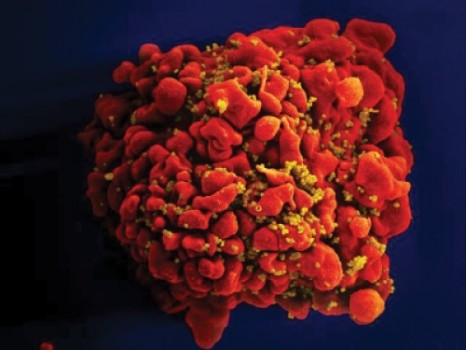
People who recently have been infected with HIV may not be as highly infectious as previously believed, a finding that could improve global efforts to prevent HIV transmission and save lives. In particular, the finding bolsters the strategy of treating patients with antiretroviral drugs before the onset of AIDS to prevent transmission.
Mathematical epidemiologists Steve Bellan, a postdoctoral researcher at The University of Texas at Austin, and Lauren Ancel Meyers, a biology professor at the university, authored the paper with researchers from McMaster University and Yale University. The analysis was published today in the open access online journal PLOS Medicine.
A few weeks after people are infected with HIV, they enter a months-long acute phase of infection when levels of virus in the bloodstream spike. If left untreated, this is followed by a decade-long chronic phase of infection that precedes AIDS. The acute phase has been previously associated with elevated risk for spreading HIV, even higher than expected from the viral spike. Researchers have argued that a large portion — or even the majority — of HIV transmission may arise from individuals who have just been infected, but the new analysis finds that previous estimates of infectivity during this acute phase are likely to be too high. In fact, today’s report suggests one of the most commonly cited estimates could be as much as 20 times too high.
“We found that people are less likely to spread HIV to others during this early stage than has been believed for many years,” Bellan said. “Our new estimates imply that some novel strategies to control HIV may be even more effective, and it can help communities to direct public health resources to save more lives.”
Estimating infectivity during acute-phase HIV is notoriously difficult, and only one study, involving heterosexual couples in Rakai, Uganda, has ever measured it directly. The new study took two complementary approaches to estimate the additional risk of transmission during the acute phase. The first analysis used data from the Rakai study but accounted for differences among the couples that were ignored in earlier studies; the second analysis estimated infection risk from measurements of virus levels throughout the acute phase. Both approaches found that the risk of transmission is indeed higher during the acute phase than the chronic phase, but the amount of additional risk during the acute phase is equivalent to only eight extra months of chronic-phase infectivity. By contrast, the most commonly cited earlier estimates suggest that the HIV acute phase produces risk equivalent to 31-141 extra months of chronic-phase infection.
“One of the biggest challenges to eliminating HIV is diagnosing people before they have the chance to infect others,” Meyers said. “If newly infected people are not as infectious as previously believed, then we can be more optimistic about the global impact of HIV ‘treatment as prevention’ efforts.”
An estimated 2 million people each year become newly infected with HIV, the disease that causes AIDS. Treating HIV-infected individuals with antiretroviral drugs not only prevents AIDS, but also makes them unlikely to infect others. In the past five years, policy has consequently shifted toward programs that aim to keep HIV infections from spreading across a population by administering antiretroviral treatment as a preventive strategy. However, individuals can only be treated once they are tested and diagnosed, and individuals rarely get tested within the first few months after infection.
Because of this lag between infection and diagnosis, these “treatment as prevention” programs are unlikely to prevent transmission from acutely infected individuals, and some have questioned whether the strategy prevents much of HIV’s spread. The new analysis suggests it’s less likely that newly infected patients could undermine the strategy’s impact. By contrast, programs focused entirely on early identification of the disease may not be as cost-effective as once thought for controlling HIV’s spread.
Story Source:
The above story is based on materials provided by University of Texas at Austin. The original article was written by Christine S Sinatra. Note: Materials may be edited for content and length.
Journal Reference:
- Steve E. Bellan, Jonathan Dushoff, Alison P. Galvani, Lauren Ancel Meyers. Reassessment of HIV-1 Acute Phase Infectivity: Accounting for Heterogeneity and Study Design with Simulated Cohorts. PLOS Medicine, March 2015 DOI: 10.1371/journal.pmed.1001801
